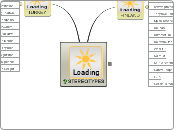Chapter 11: Play
Materials for Play
Controversial Classroom Materials
war play
some consider it a part of children's emotional development and growing awareness of the world
technology
noneducaitonal television shows
toys that promote racial or gender stereotyping
toys that promote violence
Categories of Play Materials
general consensus: children benefit from a balance of play materials
can be categorized by the different domain of development supported
realistic vs. nonrealistic
can be categorized by the type of plas
Lego blocks for construction play
costumes fo dramatic play
closed ended, such as puzzles, which are generally only used one way
open ended: can be used in many different creative ways
Educational Play Materials
play materials for educational purposes have been used for centuries
literacy materials
puzzles
small manipulative materials
classrooms usually have dramatic play materials
Caroline Pratt developed unit blocks
however, research shows that some materials labeled good for the brain are not helping children get "smarter" and may be harmful
increased knowledge about brain development influenced how materials are selected for classrooms
Cognitive Lenses on Play
Vygotsky on Play
unlike Piaget's view of play, for Vygotsky play=learning
play is not just a stage, it is how children expand their thinking, supported in their ZPD, to think on higher levels
children are predisposed to play, and socially constructed to play
saw pretend play as zone of proximal development
Piaget on Play
inspired research on the effects of play interventions
play is important in Piaget's understanding of thinking
argued for including pretend play as a necessary part of the curriculum for disadvantaged children
play is how children assimilate their experience, and how they practice their thinking
Contemporary Directions for Early Childhood Play
Play in Contemporary Education
play is challenged by the accountability movement and NCLB
play in classroom is challenged: direct instruction to teach literacy is official policy
early childhood classrooms resemble older grades in that children spend more time with pencil-and-paper tasks
the amount of time for recess is declining dramatically
shown to improve on-task behavior, recess is still cut as "noninstructional" time
pressure to show results on concrete or standardized assessments
Postmodern Play Analyses
strives to understand children's play from the perspective of social justice and equality
research suggests many biases entrenched in educational play
play can become a tool for establishing and reinforcing society's inequities and biases
asks how play becomes a context for children confronting larger social issues
Multiple Meanings of Play
some argue that play can be read as a text for layers of meaning
however, it also relates to our larger societies
play represents thinking and interacting according to children's stages of development
Social and Communications Lenses for Play
Culture and Social Play Communications
when children play together they form their own peer cultures
peer culture is a concern for adults and educators because it often challenges authority
children's play culture usually separates from the values and desires of adults in the culture
shared communication bonds playmates and develops children's group identity
Play as a Social Setting
with adult guidance children can develop and refine their strategies for negotiating more successfully
play required negotiation and develops social skills
Signaling to Create Play
players use signals to communicate with each other
language used in play may be the foundation of literacy
children play with their voices and expressions in pretend play
children learn to respond to social cues through play
Play's History
Science and Developmental Play
Montessori method essentially involves play, though the children's work activities are not called play, and are carefully planned, not free play
John Dewey argued that play was children's learning experience
G. Stanley Hall included play as a key element in his recapitulation theory of child development
believed children's play goes through seven developmental stages
argued that children repeat the evolutionary history of humans as they play
Froebel and Play Curriculum
differences about the meaning of play were debated:
developmentalists wanted more free play and choice, and for teacher to use play as a way of studying children's needs and growth
traditionalists wanted to maintain prescribed use of objects with teacher guiding children towards patterns through play
ideas on play based on natural learning between mother and child
argued that women make the best teachers
in Froebel's kindergarten curriculum, children were to play naturally with objects and each other to gain understanding









